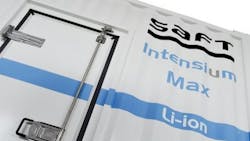Modular Rack Design Provides 8.7 MW of Battery Capability for SEPTA Subway Line
Saft has been awarded a multi-million dollar contract from ABB to support a Constellation project to install a wayside lithium-ion (Li-ion) energy storage system for the Southeastern Pennsylvania Transportation Authority (SEPTA). This project will supply 8.7MW of frequency regulation support for the PJM Interconnection electric grid and will be capable of capturing, storing, and reusing braking energy from subway cars. Saft’s batteries will be deployed between seven SEPTA substations across Philadelphia. This project will expand the existing 1.8MW of Saft storage systems from two earlier deployments with SEPTA, and the new network will increase total battery storage capacity to more than 10MW.
Constellation will fund, own, and operate the 8.7MW project which requires no upfront capital investment from SEPTA. It will be financed through a 20-year battery services agreement between SEPTA and Constellation. Viridity Energy will provide energy market services for the project, bidding the battery network into the PJM market as a frequency regulation resource.
Saft is supplying custom-designed distributed rack-based high-power battery systems using Synerion® 24P modules. In earlier deployments with SEPTA, Saft supplied Intensium® Max20 containerized solutions. Designed for high-power operation and high energy throughput, the newly launched design includes HVAC and fire suppression systems for each rack. Synerion® 24P technology offers storage with a modular design, combining significant operational reliability over thousands of cycles with exceptional energy efficiency.
SEPTA’s Energy Optimization project, designed to reduce electric energy consumption, captures energy from rail cars through a regenerative braking process. The stored energy is used to power trains and perform demand-side grid regulation service. Proving successful with cost savings and sustainability contributions in the pilot phase, the project is moving to full deployment.
“Customizing our solutions in each phase of a project is essential for continued success,” said Bowling. “This third phase requires a demanding technical application that features Saft’s modeling expertise and high power system capability.”
